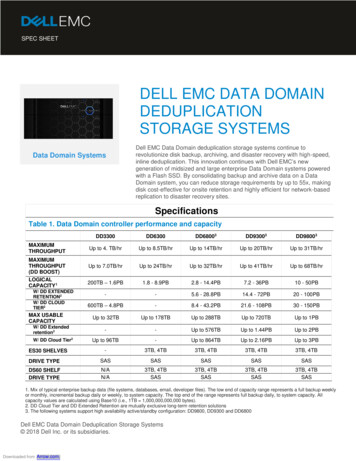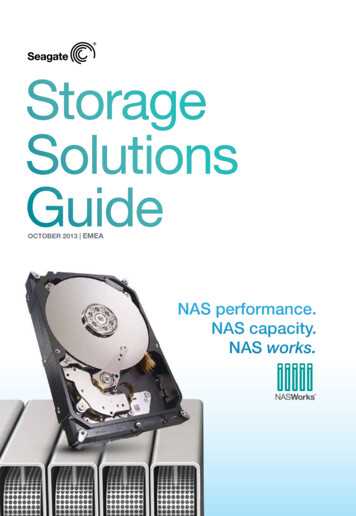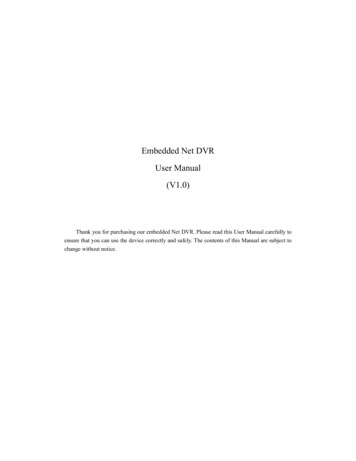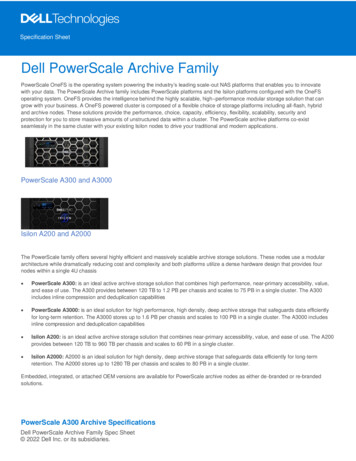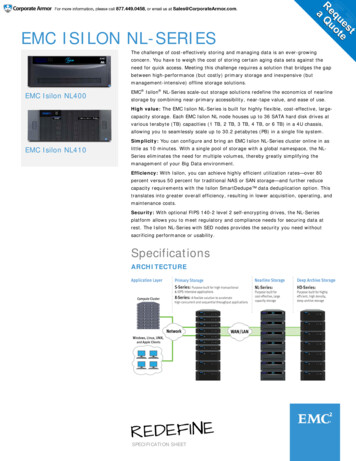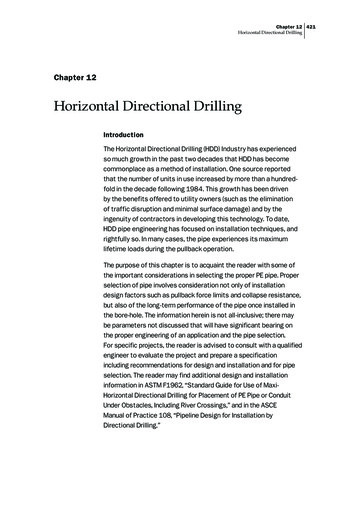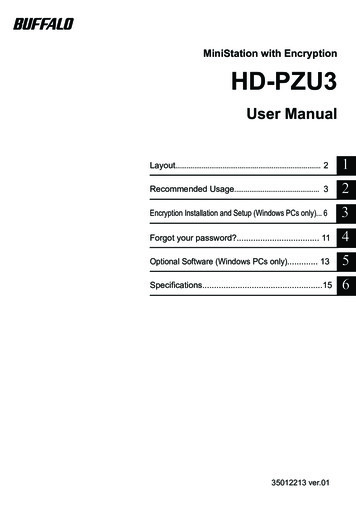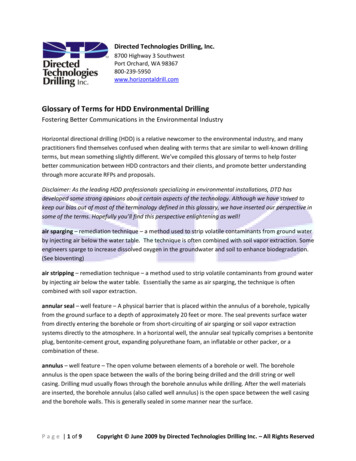
Transcription
Directed Technologies Drilling, Inc.8700 Highway 3 SouthwestPort Orchard, WA 98367800-239-5950www.horizontaldrill.comGlossary of Terms for HDD Environmental DrillingFostering Better Communications in the Environmental IndustryHorizontal directional drilling (HDD) is a relative newcomer to the environmental industry, and manypractitioners find themselves confused when dealing with terms that are similar to well-known drillingterms, but mean something slightly different. We’ve compiled this glossary of terms to help fosterbetter communication between HDD contractors and their clients, and promote better understandingthrough more accurate RFPs and proposals.Disclaimer: As the leading HDD professionals specializing in environmental installations, DTD hasdeveloped some strong opinions about certain aspects of the technology. Although we have strived tokeep our bias out of most of the terminology defined in this glossary, we have inserted our perspective insome of the terms. Hopefully you’ll find this perspective enlightening as well!air sparging – remediation technique – a method used to strip volatile contaminants from ground waterby injecting air below the water table. The technique is often combined with soil vapor extraction. Someengineers sparge to increase dissolved oxygen in the groundwater and soil to enhance biodegradation.(See bioventing)air stripping – remediation technique – a method used to strip volatile contaminants from ground waterby injecting air below the water table. Essentially the same as air sparging, the technique is oftencombined with soil vapor extraction.annular seal – well feature – A physical barrier that is placed within the annulus of a borehole, typicallyfrom the ground surface to a depth of approximately 20 feet or more. The seal prevents surface waterfrom directly entering the borehole or from short-circuiting of air sparging or soil vapor extractionsystems directly to the atmosphere. In a horizontal well, the annular seal typically comprises a bentoniteplug, bentonite-cement grout, expanding polyurethane foam, an inflatable or other packer, or acombination of these.annulus – well feature – The open volume between elements of a borehole or well. The boreholeannulus is the open space between the walls of the boring being drilled and the drill string or wellcasing. Drilling mud usually flows through the borehole annulus while drilling. After the well materialsare inserted, the borehole annulus (also called well annulus) is the open space between the well casingand the borehole walls. This is generally sealed in some manner near the surface.P a g e 1 of 9Copyright June 2009 by Directed Technologies Drilling Inc. – All Rights Reserved
back reamer – drilling tool – A tool designed to enlarge a pilot hole. A reamer is usually employed byattaching it to the drill string once the drill head exits the ground (in a surface to surface installation).The tool can also be used to forward ream a hole, but typically requires a pilot to be attached for thisuse.bentonite – drilling material – A mineral used for making drilling mud and for sealing the upper part of awell annulus. Bentonite is a clay mineral, generally mined in Wyoming. It is noted for its ability to swellupon introduction of water into its crystal matrix, with different qualities of bentonite swelling (yielding)at different amounts and rates. Wyoming bentonite is typically high yield; the individual bentonitelattice structures swell to several times their original size when hydrated. Bentonite has traditionallybeen used as a drilling mud in vertical wells; it is used by most utility HDD contractors, as well. Bentonitehas several advantages for general purpose drilling: It is inexpensive It is effective in building a filter cake that lines the borehole walls and prevents loss of drillingfluid and inflow of formation water during drilling Bentonite-based drilling mud supports the borehole walls well Bentonite-based drilling mud has relatively high viscosity and density, and effectively removescuttings from the borehole Bentonite has a relatively high lubricity, and prevents friction during drilling and insertion of wellmaterials.The primary disadvantage of bentonite in an HDD well is that it is very difficult to remove fromhorizontal wells after completion. This is largely due to the very low open area of horizontal wellscreens, combined with borehole collapse in horizontal borings. This has a direct effect on wellperformance, since many of the features listed as benefits above during drilling become liabilities duringwell operation. For this reason, DTD uses bentonite infrequently, usually only in drilling projects where awell screen is not installed. The preferred alternative to bentonite for environmental wells isbiodegradable polymer mud.biodegradable polymer mud (biopolymer mud) – drilling material – A drilling fluid used in horizontaldirectional wells. The mud comprises a blend of naturally-derived vegetable gums that create longpolymer chains when hydrated. These drilling fluids provide similar benefits as bentonite drilling mudwhile advancing the borehole, but break down to simple sugars and water after the well screen hasbeen installed and developed. The primary advantage of biodegradable polymer mud is that it has noresidual negative effect on well performance, as is the case with bentonite. The primary disadvantage ofbiodegradable polymer mud is its cost, which is several times that of bentonite for equal volumes.Biopolymer mud properties can be extremely variable depending on the proportions used in the mix,and inferior mixes are far less capable of creating a borehole seal and have less ability to carry cuttingsfrom the borehole.P a g e 2 of 9Copyright June 2009 by Directed Technologies Drilling Inc. – All Rights Reserved
bioaugmentation – remediation technique – A method used to degrade environmental contaminants byintroducing microorganisms to enhance cleanup. The microorganisms (bacteria or fungi) consume oralter the hazardous components, rendering them less harmful or binding them to prevent migration.)bioremediation – remediation technique – A remediation technique used to degrade environmentalcontaminants using native microorganisms. Typical bioremediation methods increase the availablenutrients or oxygen to native populations of microorganisms in order to enhance their activity.bioventing – remediation technique – A method used to enhance bioremediation by increasing theoxygen supply to native in situ organisms.blind well – drilling term – A horizontal, directionally drilled well that is drilled and completed from oneend. These are also called single-entry wells. To install a blind well, a pilot bore is drilled at the desiredlocation and depth, using a guidance system and steering. Then the pilot bit is removed from theborehole. In most cases the pilot bore must be reamed to a larger size prior to well casing installation, soa forward reamer is attached to the drill string and is advanced through the pilot bore. This may be donein stages, if the bore diameter is large. Finally, the reamer is removed and the well materials (screen andcasing) are pushed into the borehole.bore or borehole – drilling term – The elongated cavity created by the drilling process. Often theborehole is not a void, but rather a hole filled with drilling mud and cuttings. Well casing is pulled orpushed into the borehole to complete a well.BOREGEL – drilling material – A drilling mud manufactured by BAROID consisting of bentonite,polymer, and soda ash. Typically used in horizontal directional drilling for utilities. Because it containsbentonite, BOREGEL is usually not suitable for environmental applications.box – drilling term – The female thread portion of a drill rod.bubbling pressure or air entry value or threshold pressure – remediation term – The pressure requiredto force air into the saturated zone.cable sonde – drilling tool – A downhole transmitter or probe that is powered by electricity from theground surface rather than batteries internal to the probe. The cable sonde is connected to a powersource on the drill rig by a wire that is run inside the drill rod. With the addition of each rod to the drillstring, a length of wire must be threaded through the rod and attached to the wire extending from theexisting string. The surface end of the wire is attached to a swivel arrangement that provides electricalcontact at the drill rig.casing – drilling term – The non-perforated or non-slotted pipe that comprises the entry and exitsections of a horizontal well, as opposed to the well screen. Surface casing is a pipe that is set throughloose surficial deposits to stabilize the bore so the deeper sections can be drilled without difficulty fromcaving or collapse in the upper section of the borehole.P a g e 3 of 9Copyright June 2009 by Directed Technologies Drilling Inc. – All Rights Reserved
chinese finger – drilling equipment – A woven wire device used to pull materials into a bore. The fingeris placed over the material. When it is pulled, it tightens on the material, becoming tighter the harder itis pulled upon.CleanDrill - drilling material – A biopolymer drilling powder manufactured by CETCO primarilyconsisting of corn starch, guar gum, and xanthan gum. When mixed with water the viscous drilling fluidis stable for 24-36 hours, after which time biological action begins to consume the long chain polymersand convert them to sugars and carbon dioxide. The thinning of the drilling fluid to the viscosity ofwater can be accelerated by injecting enzyme breaker or a hypochlorite solution into the well.compaction reamer – drilling tool – A type of reamer that enlarges a borehole diameter throughcompaction of the soil surrounding it. In an environmental well, which requires good hydrauliccommunication with the surrounding formation, compaction of the formation surrounding the well boreis generally not beneficial.CON DET – drilling material – A water soluble anionic surfactant manufactured by BAROID used toprevent formation materials from balling and sticking to drilling tools.cornstarch – drilling material – A common food ingredient, cornstarch is a polymer used to thickenliquids. The starch is concentrated from grains of corn by the removal of sperm, endosperm, gluten andother compounds. In drilling the cornstarch powder is mixed with other polymers to create a drillingfluid.deflection – drilling term – The amount of flex exhibited by the drill rods. The drill head is steered bypushing it into the formation without rotation. There are limits to which the rods can be pushed beforethey deflect excessively.double-entry well – drilling term – A horizontal, directionally drilled well that is drilled and completedfrom both ends. To install a double-entry well, a pilot bore is drilled at the desired location and depth,using a guidance system and steering. The pilot bore is steered to the surface at the distal end of thewell, where the drill bit is removed. In most cases the pilot bore must be reamed to a larger size prior towell casing installation, so a reamer is attached to the drill string and is pulled back through the pilotbore. As the reamer is retracted, additional drill rods are added behind it, to maintain a continuousstring of drill steel through the borehole. This may be done in stages, if the bore diameter is large. Whenthe final diameter is achieved, the product line (well casing, conduit, etc.) is attached to the drill stringand pulled back.DrillTerge – drilling material – A water soluble anionic surfactant manufactured by CETCO used toprevent formation materials from balling and sticking to drilling tools.drilling mud – drilling material – aqueous slurry that is used during drilling to transport drill cuttingsfrom the borehole, prevent borehole collapse, and provide lubrication for the drill string. Mosthorizontal drilling uses drilling mud of some sort, although in some conditions it is possible or preferableP a g e 4 of 9Copyright June 2009 by Directed Technologies Drilling Inc. – All Rights Reserved
to drill using air or water. Drilling mud made be made using the mineral bentonite, synthetic or naturalpolymers, or some combination of the two.dry hole – drilling term – A condition that occurs when the drilling tools advance beyond the drillingmud. Typically caused by trying to advance the borehole too quickly.EnviroFlex well screen – drilling material – A type of well screen, developed by DTD employees forhorizontal well applications, that employs an internal filter membrane to prevent fine grained soil fromentering the well interior.enzyme breaker – drilling material – A liquid solution containing proteins produced through biologicalaction that act as a catalyst to speed the biodegradation of the long chain polymers that composebiodegradable drilling fluids. CETCO manufacturers an enzyme breaker named LEB-CD to break downCleanDrill drilling fluid. The LEB-CD is mixed with low pH water and injected into the bore to break thedrilling fluid.EZ MUD - drilling material – A polymer additive used to increase viscosity and gel strength ofbentonite drilling mud.fiberglass reinforced epoxy (FRE) – well casing and screen material – FRE has high tensile strength,moderate compressive strength and slots cut into the materials are dimensionally stable. It can bemade with strong integral bell joints or relatively weaker flush outside diameter joints. The product is ofmoderate cost, more expensive than HDPE and less expensive than stainless steel.filter cake – drilling term – The cake that forms along the walls of the borehole, composed of layeredmineral platelets in bentonite-based drilling mud. Filter cake creates a barrier between the boreholeand the formation, limiting the amount of drilling mud needed to complete the borehole and preventinginflux of groundwater.forward reamer – drilling tool – A type of reamer used to enlarge the diameter of the borehole in a blindor single-entry well.frac out – drilling term – During normal drilling operations, drilling fluid flows from the drill head andtravels up the borehole into a collection pit. If the borehole becomes obstructed, collapses, or the fluidpressure becomes too great inside the borehole, the fluid pressure can fracture the surroundingformation, creating a pathway for the fluid to migrate from the borehole, typically upward to the groundsurface.front locate point – drilling term – Walkover locating systems determine the azimuth of the drill headusing the magnetic field created by the down hole transmitter (sonde). This magnetic field is hourglassin shape when viewed in map view, in front of the sonde the field is positive and behind the field isnegative. The Front Locate is the point in the magnetic field created by the sonde where the field isboth positive and oriented vertically.P a g e 5 of 9Copyright June 2009 by Directed Technologies Drilling Inc. – All Rights Reserved
gel strength – drilling term – The property of drilling fluid that permits it to suspend and transport drillcuttings from the borehole. More specifically defined as the shear stress measured at low shear rateafter a mud has set quiescently for a period of time (10 seconds and 10 minutes in the standard APIprocedure, although measurements after 30 minutes or 16 hours may also be made).guar – drilling material – A common food ingredient, guar is a polymer used to thicken liquids. It isproduced by milling the dehusked seed of the Guar Tree (a species native to India and Pakistan). Indrilling the guar powder is mixed with other polymers to create a drilling fluid.high density polyethylene (HDPE) - well screen or casing material – HDPE is often used for horizontalenvironmental wells because of its flexibility, chemical resistance, cost, and moderate tensile strength.Its low compressive strength limits its use in blind well installation.hydro-lock – drilling term – A condition where the well casing and screens become “locked” in theborehole during pullback. This occurs when borehole collapse traps drilling inside the borehole in frontof or behind the well materials. Pressure increases (or decreases) to the point where the drill can nolonger pull the casing into the hole.hypochlorite – drilling material – Either calcium (powder) or sodium (liquid) based, these compoundsare chlorine and bleach compounds typically used in cleaning and sterilization. Moderateconcentrations of hypochlorite are used to rapidly reduce the viscosity of biopolymer drilling fluids.inertial guidance system – drilling tool – A system used to navigate and steer an HDD drill, usually indeep and long bores that have precise bore path requirements. The systems uses gyroscopes and/orsensitive accelerometers connected via a wireline (run inside the drill rod) to a computational subsystemin order to locate and steer the drillhead in three dimensions. In environmental drilling, the system ismost frequently used when boring depth, surface obstructions, and/or radio interference preclude theuse of a walkover or Tru-Tracker system.locator – drilling tool – A hand-held electronic device, operated by a steering technician on a drillingcrew, which works in concert with a downhole sonde to determine the drillhead depth and horizontalplacement during drilling operations. Locators are used in a walkover navigation system, which usuallyrequires that the technician has physical access to the ground surface directly above the bore path. In awalkover system the sonde broadcasts a radio signal which contains the pitch and rotary orientation ofthe drillhead. In addition, the locator interprets a magnetic field emitted by the sonde to determine thehorizontal position and depth. Displays on the locator present the depth, pitch, and rotary orientationfor the steering technician to record. The locator also transmits the data to a remote display located atthe drill rig for the driller’s interpretation.Since the depth, location, and direction of the drillhead are computed from the strength and field shapeof a broadcast electromagnetic field, this data can sometimes be distorted by local interference fromelectrical or electronic equipment or ferrous masses. The signal can be boosted, enabling use in deeperborings or in areas with electronic interference by using a wireline system, which replaces the batterywith an electrical conductor that draws power from the drill rig electrical system.P a g e 6 of 9Copyright June 2009 by Directed Technologies Drilling Inc. – All Rights Reserved
For deep installations (75 feet) or areas with other obstructions or interference, a different navigationsystem may be required. Common alternative systems use a surface coil to induce a magnetic field (TruTracker), which is detected by downhole electronics, or systems that use a compact downhole inertialguidance system.lubricity – drilling term – The lubrication properties of a given material. Certain drilling mud additivesimprove the lubricity in a borehole.packer – well material – A mechanical device used to isolate segments of a borehole or well. Packersare used to divide a well into two or more separate compartments, which can then be managedindividually, or to provide a part of an annular seal to prevent influx of surface water or communicationof injected or extracted fluids (chemicals, air, or other) between the well and the surface.pilot bore – drilling term – The initial boring made in a horizontal well installation. The pilot bore issteered, using any of several technologies, from a designated entry point, along a predetermined borepath, to a designated end point, either at the ground surface or at depth. The pilot bore subsequentlymay be reamed to a larger diameter to accommodate the desired size well screen and casing.pin – drilling term – The male threaded end of a drill rod.pitch – drilling term – The vertical angle of the drillhead in a horizontal drilling system, measured ineither percent or degrees. Most walkover systems use percent while inertial or wireline systemsmeasure in degrees. This provides a direct measurement of the dip of the drill string at or next to thedrill bit.polymer mud – drilling material – A type of drilling mud that is composed of long-chain organicmolecules. Polymer mud may also be biodegradable. Biodegradable polymer mud is preferred forhorizontal remediation well construction.pothole – drilling term – a small hole excavated from the surface to a buried utility in order to providepositive verification of its location.pre-pack casing – well material – A type of well screen that is constructed by telescoping a largerdiameter well screen over a smaller diameter one, and filling the inter-screen space with a granularfiltration material, such as sand, ceramic beads, or other media. The two screens are held in position byend caps. In horizontal environmental wells, pre-pack is often difficult to install due to its rigidity and issubject to breakage. See EnviroFlex well screen for an alternative.rear locate – drilling term – when using a walkover locating system the point along the drilling pathbehind the drill bit and the front locate point. The point in the magnetic field created by the sondewhere the field is both negative and oriented vertically.reamer – drilling tool – a cutting tool used to enlarge the diameter of a borehole after the pilot bore hasbeen drilled.P a g e 7 of 9Copyright June 2009 by Directed Technologies Drilling Inc. – All Rights Reserved
remote – drilling equipment – walkover equipment typically includes a direct reading receiver held bythe locating technician and a remote unit that receives a radio signal containing information from thelocator. The remote is located at the drilling machine and enables the driller to see the sameinformation as the locator.riser – well component – The non-slotted or non-perforated well casing that extends from a well screento the ground surface.rod wiper – drilling equipment – A rubber or synthetic grommet placed over the drill rods duringpullback to strip excess mud from the rods before they are stowed.screen – well material – Well screen is a slotted or perforated pipe, installed in a borehole, whichenables hydraulic connection with the groundwater or soil gases in the surrounding formation. It isconnected to well casing or riser pipe, which provides access to the ground surface for the installation ofpumps, conveyance of fluids, sampling, etc.sand pack – well material – In a vertical well, an attempt is usually made to create a graded filter systemsurrounding the well screen, by pouring sand down the borehole annulus, between the well screen andthe bore wall. During development, this filter, called a “sand pack” rearranges to provide progressivelygreater filtration of fine soil particles with greater distance from the surface of the well screen. In ahorizontal well, there is no practical, economical way to inject sand into the borehole annulussurrounding the well screen, which may be hundreds of feet long. Most horizontal wells are completedwith a “natural filter pack” which is simply the creation of some degree of graded filter with thecollapsed in situ soil material, through removal of fines by jetting and pumping.single-entry wellSee Blind Wellsonde – drilling equipment – The downhole component of an electronic locating system. Same as atransmitter.strike alert – drilling equipment – A protective device used while drilling that sounds an alarm if the drillstring contacts a buried electrical utility.thread compound – drilling material – An anti-seizing compound, frequently a high-pressure, copperpetroleum based grease, used to prevent the drill rods threads from seizing. It is also used to treat thethreads on threaded well screen or casing. Environmentally-friendly, inert compounds are also availablefor sampling or remediation wells.transmitter – drilling equipment – A sonde. The downhole component of an electronic locating systemthat is positioned directly behind the drill bit in the drill string. The device has gravity sensingaccelerometers that allow determination of the sondes pitch and roll. This data is transmitted either byradio signal or direct continuous wire (inside the drill rod) to the ground surface and the locatingtechnician. The device also emits a magnetic field that allows a determination of an over bit positionwhen used in with a walk-over locator. The accuracy of the over bit position is affected by ferrousP a g e 8 of 9Copyright June 2009 by Directed Technologies Drilling Inc. – All Rights Reserved
metals (either in the ground or on the ground surface) that can warp the orientation of the magneticfield.Tru-Tracker – drilling equipment – A steering tool (manufactured by Tensor ) that uses a sensor placeddirectly behind the drill bit and a wire-line coil placed on the ground surface. The wire-line coil’sposition is surveyed and when pulsed with DC current it creates an electromagnetic field of knownorientation. The borehole position is determined by sensing the orientation and strength of themagnetic field at the sensor behind the drill bit.wing cutter – drilling equipment – A reaming tool with wing-shaped extensions, used to expand the pilothole to its final diameter. A wing reamer is used to effectively mix the soil cuttings with the drilling fluidfor effective removal from the borehole.Xanthan – drilling material – A common food ingredient, xanthan is a polymer used to thicken liquids. Itis produced by the fermentation of a sugar by the Xanthomonas campestris bacteria. In drilling smallquantities of xanthan are used to thicken and increase the carrying capacity of the drilling fluid.P a g e 9 of 9Copyright June 2009 by Directed Technologies Drilling Inc. – All Rights Reserved
bore or borehole - drilling term - The elongated cavity created by the drilling process. Often the borehole is not a void, but rather a hole filled with drilling mud and cuttings. Well casing is pulled or pushed into the borehole to complete a well. BOREGEL - drilling material - A drilling mud manufactured by BAROID consisting of bentonite,
